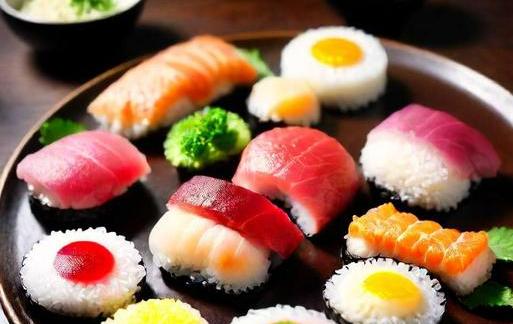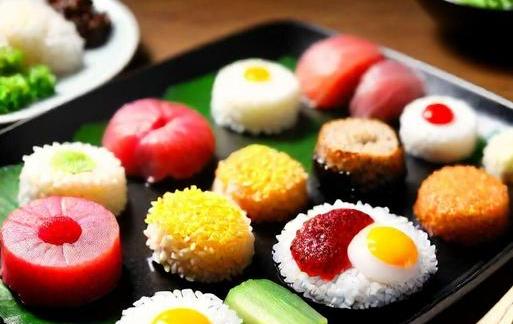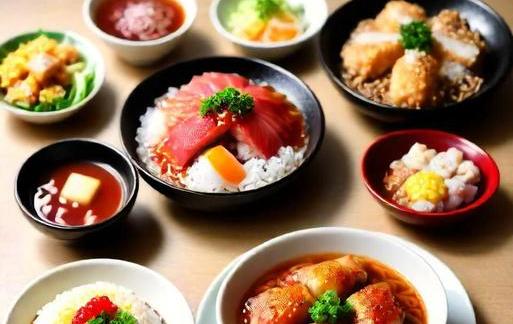- You are here:
- Home »
- Food
- » [REVEALED] Japanese Foods That Start With A
[REVEALED] Japanese Foods That Start With A
Note: This page contains affiliate links.
As an Amazon Associate, I earn from qualifying purchases when you click on the link, but you are not charged extra.
Japanese cuisine is renowned worldwide for its exquisite flavors, meticulous preparation, and cultural significance. From sushi to ramen, the diverse range of Japanese dishes has captivated food enthusiasts globally. In this culinary exploration, we delve into the world of Japanese foods that start with the letter "A." From traditional delicacies to modern culinary creations, this list showcases the rich tapestry of flavors that Japan has to offer.
Contents
List Of Japanese Foods That Start With A

1. Agedashi Tofu
Description:
Agedashi Tofu, a popular appetizer in Japanese cuisine, is a dish where cubes of tofu are deep-fried until golden brown and served with a flavorful dashi-based sauce. The exterior is crispy, while the inside remains silky and smooth. Garnished with grated daikon, green onions, and bonito flakes, Agedashi Tofu is a delightful harmony of textures and umami.
Ingredients:
- Firm tofu
- Potato starch
- Dashi (Japanese fish stock)
- Soy sauce
- Mirin (sweet rice wine)
- Grated daikon radish
- Green onions
- Bonito flakes
Preparation:
- Cut tofu into cubes and coat with potato starch.
- Deep-fry until golden brown.
- Prepare dashi-based sauce with soy sauce and mirin.
- Pour the sauce over the fried tofu.
- Garnish with grated daikon, green onions, and bonito flakes.
2. Anmitsu
Description:
Anmitsu is a traditional Japanese dessert that originated in the Meiji era. It consists of agar jelly cubes, sweet azuki bean paste, various fruits, and a dollop of ice cream, usually served with a black sugar syrup called kuromitsu. This delightful and visually appealing dessert provides a mix of textures and flavors, making it a favorite during the hot summer months.
Ingredients:
- Agar agar
- Sweet azuki bean paste
- Assorted fruits (such as peaches, mandarin oranges, and cherries)
- Matcha-flavored ice cream
- Kuromitsu (black sugar syrup)
Preparation:
- Prepare agar jelly cubes using agar agar.
- Arrange the jelly cubes, sweet azuki bean paste, and assorted fruits in a bowl.
- Top with matcha-flavored ice cream.
- Drizzle kuromitsu over the dessert.
3. Aji Fry (Horse Mackerel Fry)
Description:
Aji Fry is a classic Japanese dish featuring horse mackerel fillets coated in panko breadcrumbs and deep-fried to a golden perfection. The result is a crispy exterior with moist and flavorful fish inside. Aji Fry is often served with a side of shredded cabbage, tonkatsu sauce, and lemon wedges, creating a delicious combination of savory and tangy flavors.
Ingredients:
- Aji (horse mackerel) fillets
- Flour
- Beaten eggs
- Panko breadcrumbs
- Shredded cabbage
- Tonkatsu sauce
- Lemon wedges
Preparation:
- Dredge aji fillets in flour, dip in beaten eggs, and coat with panko breadcrumbs.
- Deep-fry until golden brown.
- Serve with shredded cabbage, tonkatsu sauce, and lemon wedges.
4. Akashiyaki
Description:
Akashiyaki is a specialty of the city of Akashi in Hyogo Prefecture. These small, round dumplings are made with a batter of eggs and dashi, filled with octopus, green onions, and tenkasu (crispy tempura scraps). Cooked in a unique ball-shaped mold, Akashiyaki are typically enjoyed dipped in a savory broth or a sweet soy-based sauce.
Ingredients:
- Eggs
- Dashi
- Flour
- Octopus
- Green onions
- Tenkasu (tempura scraps)
- Broth or soy-based sauce for dipping
Preparation:
- Mix eggs, dashi, and flour to create the batter.
- Fill the batter with diced octopus, green onions, and tenkasu.
- Cook in a special ball-shaped mold until golden brown.
- Serve with a dipping sauce or broth.
5. Aemono (Vegetable And Seafood Salad)
Description:
Aemono refers to a category of Japanese salads where vegetables, seafood, or a combination of both are dressed with a flavorful and often umami-rich dressing. The dressing can vary, including ingredients like miso, sesame, or soy sauce. Aemono salads showcase the art of balancing textures and tastes, creating a refreshing and satisfying dish.
Ingredients:
- Assorted vegetables (cucumber, seaweed, carrots)
- Cooked seafood (shrimp, squid, or crab)
- Miso, sesame, or soy-based dressing
Preparation:
- Prepare vegetables and seafood.
- Mix with a dressing of your choice.
- Serve chilled as a refreshing salad.
6. Ankake Yakisoba
Description:
Ankake Yakisoba is a variation of the popular Japanese fried noodle dish, Yakisoba. What sets it apart is the addition of a starchy, thick sauce known as ankake. The noodles are stir-fried with various vegetables and meat, then coated in the savory ankake sauce, creating a hearty and flavorful one-pan meal.
Ingredients:
- Yakisoba noodles
- Vegetables (cabbage, carrots, onions)
- Meat (pork, chicken, or seafood)
- Soy sauce
- Mirin
- Worcestershire sauce
- Ketchup
- Cornstarch for ankake sauce
Preparation:
- Stir-fry noodles with vegetables and meat.
- Mix soy sauce, mirin, Worcestershire sauce, and ketchup for the ankake sauce.
- Thicken the sauce with cornstarch and pour over the yakisoba.
7. Atsuyaki Tamago (Thick Grilled Omelette)
Description:
Atsuyaki Tamago, or thick grilled omelette, is a beloved dish in Japanese cuisine. Made with a sweetened egg mixture, this omelette is cooked layer by layer, resulting in a beautifully rolled and dense final product. Atsuyaki Tamago is often served as a sweet treat or used as a filling in sushi rolls.
Ingredients:
- Eggs
- Sugar
- Soy sauce
- Dashi
- Mirin
Preparation:
- Whisk together eggs, sugar, soy sauce, dashi, and mirin.
- Cook the mixture layer by layer, rolling it as it cooks.
- Slice into rounds for serving or use as a sushi filling.
8. Asazuke (Quick Pickles)
Description:
Asazuke refers to Japanese quick pickles that are typically marinated for a short period, resulting in a crisp texture and vibrant flavor. Commonly made with vegetables like cucumbers, daikon radish, or cabbage, Asazuke is a refreshing and palate-cleansing accompaniment to a Japanese meal.
Ingredients:
- Vegetables (cucumbers, daikon radish, cabbage)
- Salt
- Rice vinegar
- Soy sauce
- Sugar
- Red pepper flakes (optional)
Preparation:
- Slice vegetables thinly and sprinkle with salt.
- After a short marination, rinse the vegetables.
- Mix with a dressing of rice vinegar, soy sauce, sugar, and red pepper flakes if desired.
9. Agedama (Sweet Crunchy Toppings)
Description:
Agedama, or sweet crunchy toppings, are often used as a garnish for various Japanese dishes. These golden-brown crispy bits are made by deep-frying tempura batter until crunchy. Agedama adds texture and a touch of sweetness to dishes like udon, donburi, or takoyaki.
Ingredients:
- Tempura batter (flour, water, egg)
- Sugar
Preparation:
- Make tempura batter by mixing flour, water, and egg.
- Deep-fry small droplets until golden brown.
- Sprinkle with sugar for a sweet crunch.
The world of Japanese cuisine is vast and varied, offering a plethora of dishes that start with the letter "A." From the crispy delights of Agedashi Tofu to the sweet elegance of Atsuyaki Tamago, each dish reflects the meticulous craftsmanship and culinary artistry ingrained in Japanese culture. As we’ve explored this curated list, it’s evident that Japanese cuisine goes beyond sushi and ramen, showcasing a diverse range of flavors, textures, and cooking techniques. So, whether you are a seasoned fan of Japanese cuisine or a curious newcomer, exploring these "A" dishes will undoubtedly provide a deeper appreciation for the rich culinary heritage of Japan.
Significance

Japanese cuisine is renowned for its rich flavors, meticulous preparation, and cultural significance. The diversity within Japanese culinary traditions offers a vast array of dishes, each with its own unique characteristics. In this exploration, we focus on Japanese foods that start with the letter "A," delving into the significance, categories, common themes, interesting facts, and more.
Understanding the significance of Japanese foods starting with "A" requires a glimpse into the broader cultural and culinary landscape of Japan. Food plays a crucial role in Japanese culture, symbolizing harmony, balance, and respect for nature. The meticulous preparation and presentation of dishes reflect the deep cultural values ingrained in the Japanese way of life.
The letter "A" might seem arbitrary, but as we delve into the culinary world, we discover the diverse and delectable dishes that start with this letter, each contributing to the mosaic of Japanese gastronomy.
Category-Related

1. Amazake
Amazake, a traditional Japanese sweet drink, is a prominent representative of Japanese foods starting with "A." Made from fermented rice, it carries a rich history dating back to the Kofun period (300-538 AD). Often consumed during winter and New Year festivities, Amazake not only satisfies the sweet tooth but also provides a nutritional boost.
Ingredients
- Short-grain rice
- Water
- Koji (rice malt)
Preparation
- Cook rice.
- Mix cooked rice, water, and koji.
- Allow fermentation.
2. Agedashi Tofu
Agedashi Tofu, a popular appetizer, showcases the Japanese culinary mastery in transforming simple ingredients into a culinary delight. This dish features deep-fried tofu served with a flavorful dashi-based sauce. The contrast between the crispy exterior and the silky tofu interior creates a textural symphony.
Ingredients
- Tofu
- Potato starch
- Dashi (Japanese soup stock)
- Soy sauce
- Mirin (sweet rice wine)
- Sugar
Preparation
- Cut tofu into cubes.
- Coat tofu with potato starch and deep-fry.
- Prepare the sauce using dashi, soy sauce, mirin, and sugar.
- Pour the sauce over the fried tofu.
3. Anmitsu
Anmitsu, a delightful Japanese dessert, beautifully exemplifies the art of combining various textures and flavors. This chilled dessert features agar jelly, red bean paste, fruits, and sweet syrup. It has evolved over the years, incorporating modern elements while preserving its traditional essence.
Ingredients
- Agar agar
- Anko (sweet red bean paste)
- Fruits (typically mandarin oranges and cherries)
- Kuromitsu (brown sugar syrup)
- Shiro-an (white bean paste)
Preparation
- Prepare agar jelly.
- Arrange fruits and sweet bean pastes in a bowl.
- Pour kuromitsu over the mixture.
Common Themes
Japanese foods starting with "A" often share common themes rooted in the culinary philosophy of achieving balance and harmony. Whether it’s the contrast of textures, the blending of sweet and savory flavors, or the emphasis on fresh and seasonal ingredients, these themes contribute to the unique identity of Japanese cuisine.
1. Umami Sensation
Umami, the fifth basic taste, is a prevalent theme in Japanese foods. Many dishes starting with "A" showcase the intricate balance of umami, achieved through ingredients like dashi, soy sauce, and miso. Agedashi Tofu, for example, encapsulates umami in the combination of fried tofu and savory dashi-based sauce.
2. Artful Presentation
Japanese culinary artistry extends beyond taste to visual appeal. Dishes like Anmitsu are not only a treat for the palate but also a feast for the eyes. The meticulous arrangement of colorful fruits, anko, and agar jelly reflects the Japanese commitment to aesthetic presentation.
3. Seasonal Variations
Seasonality is a key element in Japanese cuisine. Many dishes starting with "A" adapt to the changing seasons, incorporating fresh produce and ingredients available at specific times of the year. This connection to nature enhances the dining experience and reflects a deep respect for the environment.
Interesting Facts
Delving into the world of Japanese foods that start with "A" unveils intriguing facts that add layers of appreciation for the culinary heritage.
1. Amazake As A Traditional Beverage
Amazake, often referred to as a sweet beverage, has historical roots as a traditional Japanese drink. In Shinto rituals, it is used as an offering to the gods. Its association with auspicious occasions and celebrations further underscores its cultural significance.
2. Agedashi Tofu’s Culinary Evolution
Agedashi Tofu, while a classic dish today, underwent a culinary transformation over the years. Initially, it was not deep-fried but simmered. The deep-frying technique gained popularity in the Edo period, contributing to the dish’s modern identity.
3. Anmitsu’s Journey Through Time
Anmitsu, originating in the Meiji era (1868-1912), has evolved in response to changing tastes. Originally a simple dish with agar jelly and anko, it now incorporates a variety of fruits and syrups. This adaptability showcases the dynamic nature of Japanese cuisine.
Conclusion
In the realm of Japanese foods that start with "A," we find a fascinating tapestry of flavors, traditions, and culinary artistry. From the sweet embrace of Amazake to the crispy elegance of Agedashi Tofu and the colorful symphony of Anmitsu, each dish offers a unique insight into the rich tapestry of Japanese gastronomy.
The significance of these dishes extends beyond mere sustenance; they embody cultural values, historical legacies, and a profound connection to nature. As we savor the umami, appreciate the artful presentation, and embrace the seasonal variations, we embark on a culinary journey that transcends borders and invites us to explore the depth of Japanese culinary heritage.


